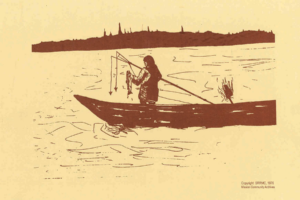STÓ:LŌ FISHING
A Cultural Practice
For at least 10,000 years, the Stó:lō people have fished the Fraser River as the original inhabitants of their traditional territory, S’olh Temexw, which extends across the Fraser Valley and Fraser Canyon. The English name of the Fraser River and Valley was named after Scottish fur trader Simon Fraser, and Stó:lō is the Halq’emeylem word for the body of water and refers to the area in which the Stó:lō live. Although settlement has dramatically changed the landscape surrounding the River, Stó:lō fishers continue to utilize their harvesting skills in the present day. Their practices are grounded in an economy of sharing, sustainability, and respect for the fish. The kinds of fish typically caught in this area include spring salmon, sockeye salmon, sturgeon, eulachons, and dog salmon.
Tools and Techniques
Stó:lō fishers have traditionally used handmade fishing tools, but in the present time, a blend of both traditional and manufactured tools are utilized. Traditional tools include harpoons, nets, hooks, and sinkers made out of processed cedar and carved stone. Some techniques used to trap fish include weirs (a passage constructed in water to direct or trap fish), bag nets (large open-mouth nets operated by four people in two boats), and dip nets (a handheld net on a long pole). Timing is also crucial: many of the months in the Stó:lō calendar are named in Halq’emeylem language to reflect important points in the fishing season. Tempo:kw the first month is time for Chehalis spring salmon (Oct 23-Nov 21), Temkwikwexel the seventh month is time for baby sockeye salmon (Apr 19-May 17), Temtheqi the eleventh month is sockeye salmon time, and Temkw’o:lexw the twelfth month is dog salmon time (Sept 14-Oct 12).
Methods and Social Responsibilities
Fishing not only includes methods for harvesting food from the river, but also represents a complex Indigenous social network to ensure that the fish population is properly managed. Stó:lō Elder Albert (Sonny) McHalsie explains that fishing practices are centered around the relationship between land and Stó:lō families. Within the Stó:lō community, there is an understanding that certain families are responsible for taking care of specific fish camp spots. Families gather and set up their preferred fishing gear, and work together to catch and process the fish harvest. After the fish is caught and butchered, a common processing method is the use of a drying rack to wind-dry fish in the summer months. Other processing methods include salting, barbequing, smoking, or canning the fish.
Disruptions
For thousands of years, Stó:lō fishers have managed their fishing practices in a way that is responsive to environmental shifts and considerate of human and non-human beings. By astute observations and careful decisions, traditional fishing practices were a system of resource management that prevented over-fishing, and ensured that there was enough food to go around. This system functioned both locally and in relation with the wider community using the potlatch system, a practice of ceremonial redistribution of food and material goods.
Between 1894 and 1914, the Canadian Department of Fisheries created a permit system, which later became the Food Fish Permit system in 1923. The permit system restricted Indigenous food fishing to three days of the week and between certain times of day, and limited what tools and techniques were permitted. Furthermore, the potlatch was banned from 1885 to 1951, which disrupted the culturally integral fish economy. Today, Indigenous fishing regulations in BC are enforced provincially by the Fish and Seafood Act, and federally by the Fisheries Act. These acts recognize Indigenous harvesting rights, but the right to sell fish is not recognized provincially, except when proven in court.

Image courtesy of the Mission Community Archives.
Bibliography: https://indigenousfoundations.arts.ubc.ca/aboriginal_fisheries_in_british_columbia/
Upper Stó:lō Fraser Valley Fishing. (2006) Coqualeetza Cultural Education Centre.







